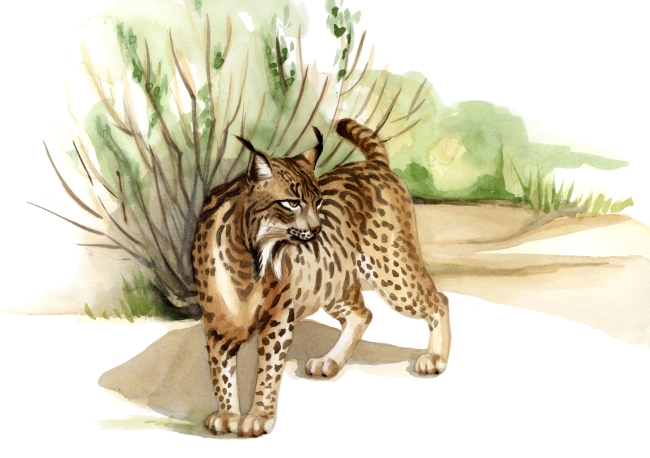Within 50 years, climate change will probably wipe out the world’s most endangered feline, the Iberian lynx, even if the world meets its target for curbing carbon emissions, biologists said on Sunday.
The gloomy forecast, published in the journal Nature Climate Change, says that without a dramatic shift in conservative strategy, the charismatic little wildcat seems doomed.
The lynx ― Latin name “Lynx pardinus” ― grows to about a meter in length, weighs up to 15 kilos, and is characterized by its spotted beige fur, pale yellow eyes and tufted ears and cheeks.
Only around 250 of the animals live in the wild, holed up in two regions in southern Spain, the Sierra Morena and the Donana National Park, according to estimates published last year.
The gloomy forecast, published in the journal Nature Climate Change, says that without a dramatic shift in conservative strategy, the charismatic little wildcat seems doomed.
The lynx ― Latin name “Lynx pardinus” ― grows to about a meter in length, weighs up to 15 kilos, and is characterized by its spotted beige fur, pale yellow eyes and tufted ears and cheeks.
Only around 250 of the animals live in the wild, holed up in two regions in southern Spain, the Sierra Morena and the Donana National Park, according to estimates published last year.

In just half a century, its range has shrunk from 40,600 square kilometers to 1,200 square kilometers, driven by efforts to wipe out the rabbit, its main food, as well as poaching and fragmentation of its grassland-and-forest mixed habitat.
The new study, led by Miguel Araujo of the National Museum of Natural Sciences in Madrid, models the impact of rising temperatures and changing rainfall patterns on habitat, rabbits and lynxes.
On current trends, the changes will occur too fast for the lynx to adapt, it suggests.
“Climate change is predicted to have a rapid and severe negative influence on Iberian lynx abundance, exceeding its ability to adapt or disperse to more climatically favorable regions where prey densities are sufficient to support viable populations,” says the study.
“We estimate time to extinction to be less than 50 years, even with rapid and deep global cuts to anthropogenic (man-made) greenhouse-gas emissions,” it said, referring to stabilizing atmospheric carbon dioxide levels to 450 parts per million.
Reaching the 450 ppm target would give a high probability of curbing warming to 2 degrees Celsius over pre-industrial levels, the goal set at U.N. climate talks.
The researchers say that the picture is not entirely bleak.
Extinction could be staved off, at least for the coming decades, by overhauling conservation strategies, they say.
At present, policymakers plan to release each year between 20 and 40 lynxes which have been bred in captivity, with the idea of placing them in their historical range ― a vast area that includes parts of western and central Spain and eastern Portugal, too.
But the study says that, rather than a general re-introduction, a smarter tactic would be to target only top-quality habitats which are least fragmented and offer the best chance of resisting climate change.
This could be done with a yearly release of six males and six females, aged between 1 and 4 years. Computer models suggest this “would avert the likely extinction of (the Iberian) lynx this century,” it adds.
(AFP)
-
Articles by Korea Herald


![[Exclusive] Korean military set to ban iPhones over 'security' concerns](http://res.heraldm.com/phpwas/restmb_idxmake.php?idx=644&simg=/content/image/2024/04/23/20240423050599_0.jpg&u=20240423183955)

![[Graphic News] 77% of young Koreans still financially dependent](http://res.heraldm.com/phpwas/restmb_idxmake.php?idx=644&simg=/content/image/2024/04/22/20240422050762_0.gif&u=)



![[Pressure points] Leggings in public: Fashion statement or social faux pas?](http://res.heraldm.com/phpwas/restmb_idxmake.php?idx=644&simg=/content/image/2024/04/23/20240423050669_0.jpg&u=)










